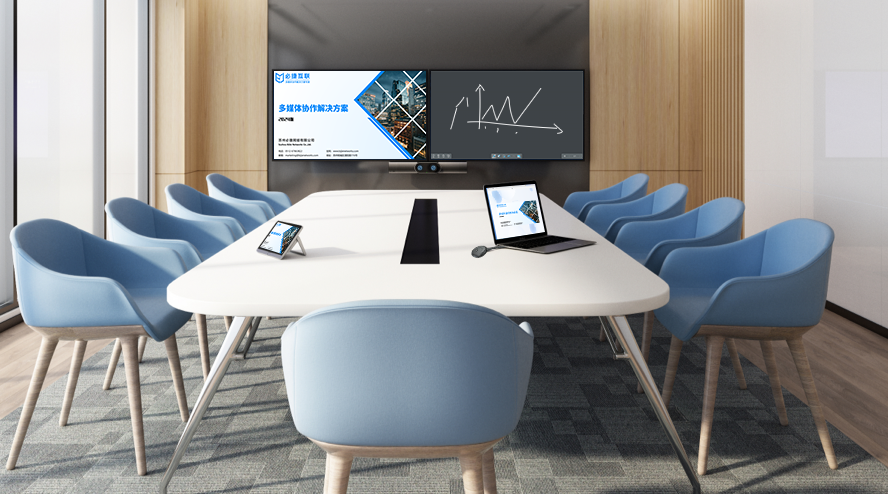PC Screen Mirroring: An Efficient Large-Screen Display Solution
This PC screen mirroring solution is designed to meet the need for a larger display of computer content. It’s compatible with Windows, macOS, and Linux, and supports both wireless and wired connections. The operation is simple and the transmission is stable, covering scenarios like meetings, classes, and design discussions. It allows documents, videos, and design drafts from your computer to easily “leap” onto a large screen.
Universal System Compatibility, Seamless Connections
Whether you’re using a Windows laptop or desktop, a MacBook with macOS, or a professional workstation with a Linux system, they all connect seamlessly. The connection methods are flexible and convenient:
- Wireless Mirroring: Use native system functions (“Project” on Windows, “Screen Mirroring” on Mac) or a QR code to pair, and you’ll be connected in under 3 seconds without having to install any plugins.
- Wired Mirroring: It supports mainstream interfaces like HDMI, Type-C, and DP. It’s plug-and-play, with no need for driver debugging, so even an older computer can connect easily. With compatibility for over 95% of devices, from office laptops to high-performance design desktops and from classic models to the latest devices, you’re not limited by brand, model, or system version.
Clear and Stable Transmission, All Details Displayed
It supports 4K Ultra HD transmission. When you mirror an architectural design drawing, the subtle differences in line curves and material textures are clearly visible. When you mirror a financial report, the small text in the tables and complex data charts are sharp and clear, making key data obvious at a glance. Using dynamic anti-interference technology, the transmission latency is as low as 20ms, and the audio-video synchronization error is less than 10ms. When playing a product demo video or a dynamic presentation, the picture is smooth with no ghosting, and the audio and video are perfectly in sync. Even fine operations like zooming in on a CAD drawing or switching PS layers are synchronized in real time, with no loss of detail.
Practical Functions for All Scenarios
Office Meetings
- Multi-Screen Comparison: It supports 2-4 computers mirroring in a split-screen view to display different proposal versions at the same time. This eliminates the need for frequent device switching, making proposal comparisons more intuitive and boosting decision-making efficiency by 40%.
- Real-Time Annotation: During a discussion, you can directly draw on the large screen to highlight key points and edit charts. The annotations are synchronized back to your computer. After the meeting, you can export them to a shared folder with one click, so you won’t miss any key ideas.
- Remote Collaboration: Remote participants can mirror the on-site team’s perspective from their computers, while the local team mirrors proposal details. The large screen displays both contents together, making remote communication feel like it’s happening in the same room.
Classroom Teaching
- Flexible Operation: A teacher can mirror courseware from their computer and use keyboard shortcuts or a remote control to turn pages, giving them the flexibility to control the presentation even from the back of the classroom. For complex formulas, they can use a stylus to annotate in real time on the computer, and the large screen will display the markings in sync, making them clearer for students to see.
- Teacher-Student Interaction: Students can mirror their homework and project reports from their computers, allowing the whole class to give feedback on the large screen. This encourages students to share their ideas proactively and makes the classroom atmosphere more lively. It also supports linking PC mirroring with an electronic whiteboard, so courseware content can be directly annotated and erased on the screen, making teaching more flexible.
Design Discussions
- Real-Time Sync: When a designer is running software like PS, CAD, or 3D Max on their computer, the operation is mirrored to the large screen in real time. The team can then gather around the large screen to discuss color palettes and modeling details. Any edits are visible in real time, so there’s no need to export images and copy them to a USB drive, which saves time.
- Multi-Device Collaboration: A designer can set a tablet as a “digital drawing pad” for their computer. The designer can sketch ideas on the tablet, and they will be simultaneously displayed on the large screen, which combines fine-tuned operation with an overall view and makes it more efficient to bring ideas to life.
Smart Management, Secure and Convenient
- Access Control: An administrator can set up a “mirroring whitelist” from a backend, allowing only authorized computers to connect, which prevents interference from unauthorized devices. It also supports a “temporary mirroring code,” where a visitor can mirror content by entering a verification code, and the permission automatically expires afterward.
- Remote Maintenance: It offers real-time monitoring of the operational status of mirroring devices and supports remote on/off, firmware upgrades, and troubleshooting, which reduces management costs because no on-site maintenance is required.
- Data Statistics: It automatically records data like the number of mirrors, duration, and device models, and generates usage reports to provide a basis for scenario optimization.
There’s no complex wiring needed; you just connect your computer to the network or use a cable. Daily maintenance is not a burden. Whether a corporate team is refining a project proposal, a class is conducting a lesson, or a design team is discussing a creative project, this PC screen mirroring solution can precisely meet your needs and make the display of computer content more efficient and professional.